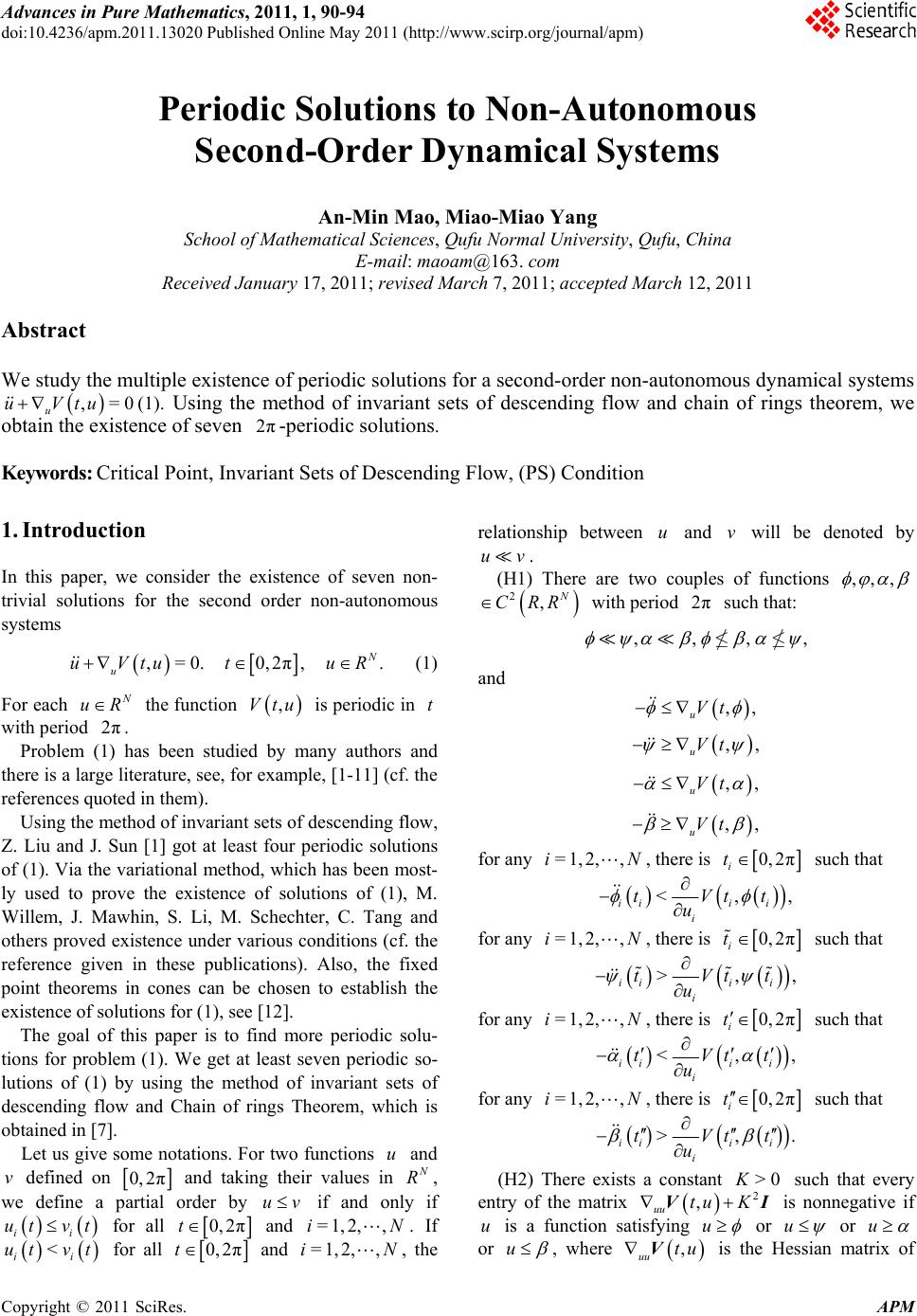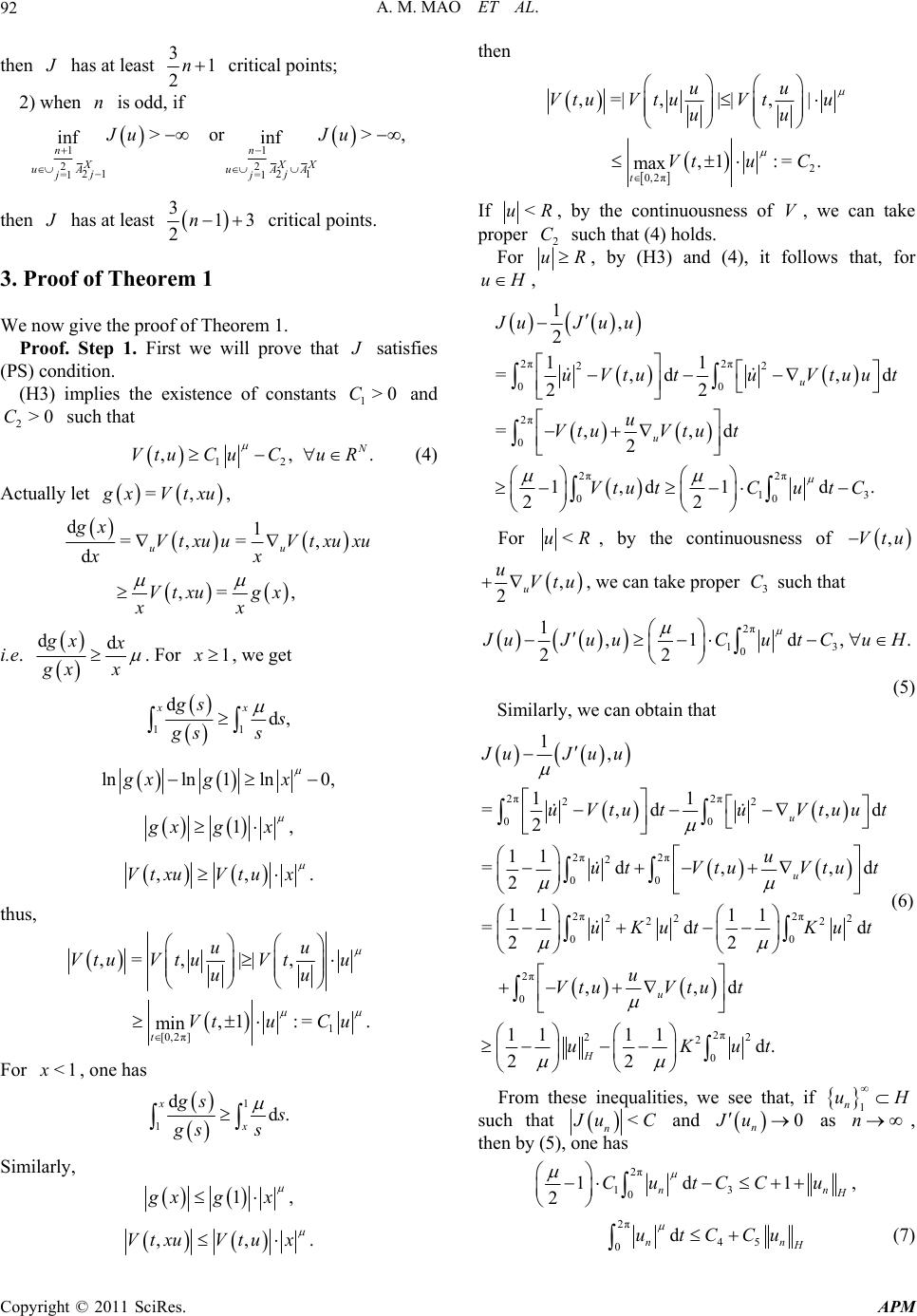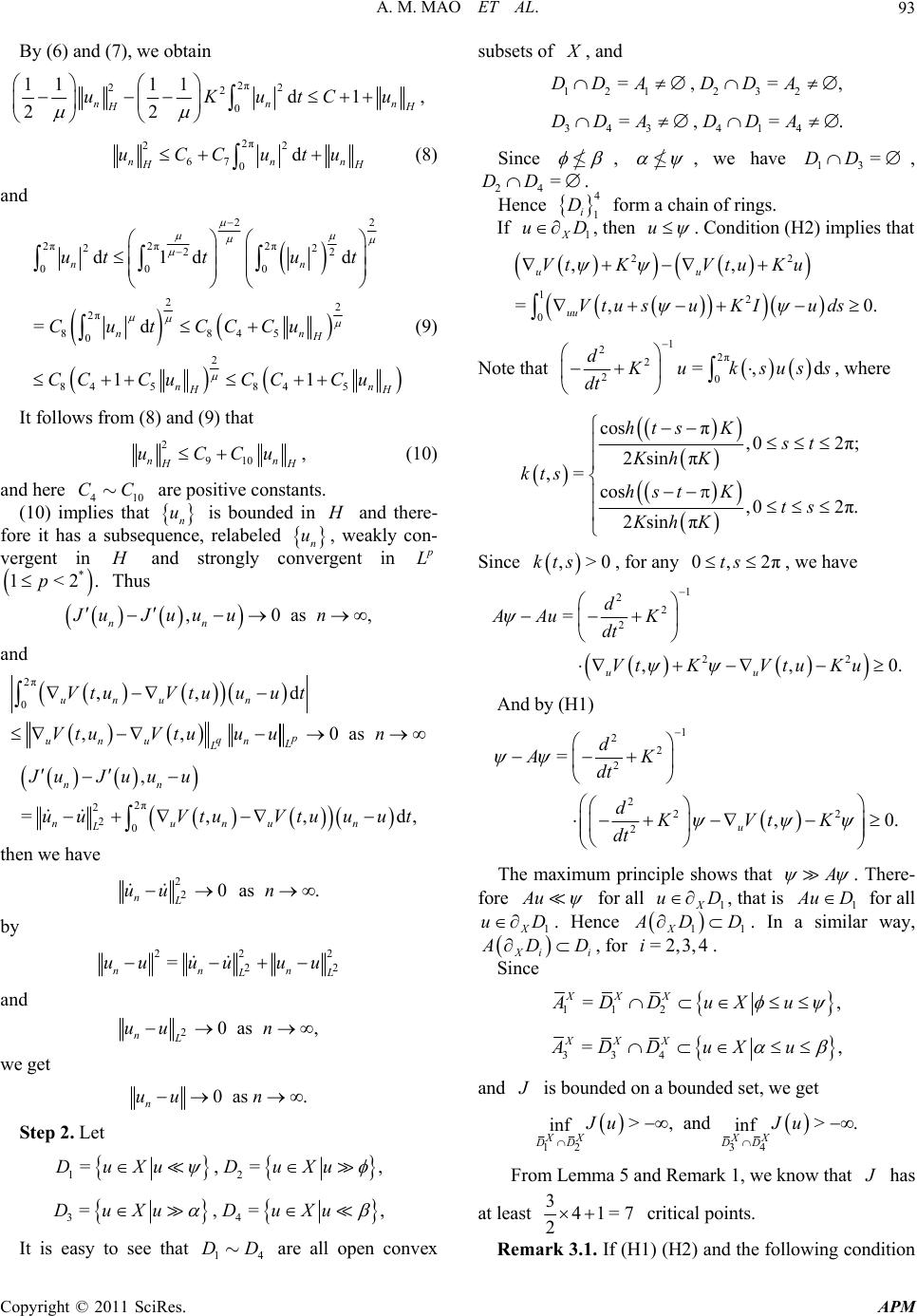 Advances in Pure Mathematics, 2011, 1, 90-94 doi:10.4236/apm.2011.13020 Published Online May 2011 (http://www.scirp.org/journal/apm) Copyright © 2011 SciRes. APM Periodic Solutions to Non-Autonomous Second-Order Dynamical Systems An-Min Mao, Miao-Miao Yang School of Mathemat i cal Sci ences, Qufu Normal University, Qufu, China E-mail: maoam@163. com Received January 17, 2011; revised March 7, 2011; accepted March 12, 2011 Abstract We study the multiple existence of periodic solutions for a second-order non-autonomous dynamical systems ,=0 u uVtu (1). Using the method of invariant sets of descending flow and chain of rings theorem, we obtain the existence of seven 2π-periodic solutions. Keywords: Critical Point, Invariant Sets of Descending Flow, (PS) Condition 1. Introduction In this paper, we consider the existence of seven non- trivial solutions for the second order non-autonomous systems ,=0. 0,2π,. u uVtu tuR (1) For each uR the function ,Vtu is periodic in t with period 2π. Problem (1) has been studied by many authors and there is a large literature, see, for example, [1-11] (cf. the references quoted in them). Using the method of invariant sets of descending flow, Z. Liu and J. Sun [1] got at least four periodic solutions of (1). Via the variational method, which has been most- ly used to prove the existence of solutions of (1), M. Willem, J. Mawhin, S. Li, M. Schechter, C. Tang and others proved existence under various conditions (cf. the reference given in these publications). Also, the fixed point theorems in cones can be chosen to establish the existence of solutions for (1), see [12]. The goal of this paper is to find more periodic solu- tions for problem (1). We get at least seven periodic so- lutions of (1) by using the method of invariant sets of descending flow and Chain of rings Theorem, which is obtained in [7]. Let us give some notations. For two functions u and v defined on 0, 2π and taking their values in R, we define a partial order by uv if and only if ii ut vt for all 0, 2πt and =1,2, ,iN. If < ii ut vt for all 0, 2πt and =1,2, ,iN, the relationship between u and v will be denoted by uv. (H1) There are two couples of functions ,,, 2, CRR with period 2π such that: ,,,, and ,, uVt ,, uVt ,, uVt ,, uVt for any =1,2, ,iN , there is 0, 2π i t such that <,, iii i i tVtt u for any =1,2, ,iN, there is 0, 2π i t such that >,, iii i i tVtt u for any =1,2, ,iN, there is 0, 2π i t such that <,, iii i i tVtt u for any =1,2, ,iN , there is 0, 2π i t such that >,. iii i i tVtt u (H2) There exists a constant >0K such that every entry of the matrix 2 , uu tu KVI is nonnegative if u is a function satisfying u or u or u or u , where , uu tuV is the Hessian matrix of  A. M. MAO ET AL. Copyright © 2011 SciRes. APM 91 V and I is the NN unit matrix. (H3) There exists >2 and >0R such that, for uR, 0<,, , u Vtuu Vtu where u means the Euclidean norm of u in R. Theorem 1. If (H1), (H2) and (H3) are satisfied, then problem (1) has at least seven periodic solutions. Remark 1.1. Conditions in Theorem 1 can be satisfied by generic functions. As examples, it can be proved that 4 2 =1 2 =2 1 N iij iij N Vu uu u satisfies all the conditions in Theorem 1. One should take 0u and 0,v in which12 ===, uu u 12 === vv v, u and v are sufficiently small. and can be chosen in the same way. Remark 1.2. Our work is based on the results in [1,7]. 2. Preliminary and Lemmas Let be the Hilbert space of vector functions ut having period 2π and belonging to 1 on 0, 2π, with the following inner product 22 0 ,= d,uvuv Kuvt where is a fixed number satisfying (H2). The corre- sponding norm in is denoted by and 2 22 22 0 =, =d. H uuu uKut Let be the Banach space of N-vector functions ut having period 2π and belonging to 1 C on 0, 2π and is continuously imbedded in . Define a functional : HR as 2π2 0 1 =,d. 2 uuVtut Then the critical points of correspond to the solu- tions of problem (1). Here :== 0 uHJu X . We have 1 2 22 2 d =, du uuK VtuKu t (2) here 1 2 2 2 d dK t is the inverse operator of 2 2 2 d d t with the periodic condition of period 2π. Denote 1 2 22 2 d =,. du uKVtuKu t Now we will explain that (2) holds: Noting that 2π 0 ,=, d, u uvuvVtuvt and 2π2 0 ,= d, uvAuvKAuvt then 2π22 0 2 222 2 0 ,,= d =d. u vAu vuvKuvAuvKAuvt d uvKAuK uv t dt For 1 2 22 2 d =, du uKVtuKu t , we have ,=, ,. uvuv Auv For 0 uX , consider the initial value problem 0 d=,0= d uuAuuu (3) both in and in . Let 0 ,uu and 0 ,uu be the unique solution of (3) in and in respectively, with maximal right existence interval 0 0, u and 0 0, u . Lemma 1. (Lemma 5.1 in [1]) 00 =uu and 00 ,=,uu uu for all 0 0<u . Moreover, if 00 ,= lim uuu u in the topology for some uK , the critical set of , then the limit is also valid in the topology. Definition 1. (Chain of rings) (Definition 5 in [7]) Assume that 12 ,,, 2 n DDD n all are nonempty path connected sets. When 4n, 1 D intersects only with 2 D and n D, 1= nn DDA . i D intersects only with 1i D , 1i D =2,3, ,1in, and 1= ii i DD A =1,2, ,1in , we say that 12 ,,, n DD D form a chain of rings. For the case of =3n, 121 =DDA, 232 =DDA , 313 =DDA , and 12 DD 3=D , we say that 123 ,,DDD form a chain of rings. For the case of =2n, 1212 =DDAA, 12 A = , we say that 1 D and 2 D form a chain of rings. Lemma 2. (Theorem 4 and Remark 5 in [7]) Assume that is a Hilbert space, 11 , CHR, u =uAu , uH , J satisfies the (PS) condition on . 12 ,,, n DD D 3n are open convex subsets of , and form a chain of rings. Xi i DD =1,2, ,in, 1) when n is even, if 22 221 =1 =1 >or >, inf inf nn XX uA uA jj jj Ju Ju  A. M. MAO ET AL. Copyright © 2011 SciRes. APM 92 then has at least 31 2n critical points; 2) when n is odd, if 11 22 212 1 =1 =1 >or >, inf inf nn XXX uA uAA jj jj Ju Ju then has at least 313 2n critical points. 3. Proof of Theorem 1 We now give the proof of Theorem 1. Proof. Step 1. First we will prove that satisfies (PS) condition. (H3) implies the existence of constants 1>0C and 2>0C such that 12 ,,. VtuCuCu R (4) Actually let =, xVtxu, d1 =,= , d ,= , uu gx Vtxuu Vtxuxu xx Vtxu gx x i.e. dd gx xx . For 1 , we get 11 dd, xx gs gs s lnln 1ln0,gx gx 1, xg x ,,.VtxuVtu x thus, 1 [0,2π] ,=,|| , ,1 :=. min t uu Vtu VtuVtu uu Vtu Cu For <1x, one has 1 1 dd. x x gs ss Similarly, 1, xg x ,,.VtxuVtu x then 2 0, 2π ,=|,||,| ,1:= . max t uu Vtu VtuVtu uu Vtu C If <uR , by the continuousness of V, we can take proper 2 C such that (4) holds. For uR, by (H3) and (4), it follows that, for uH , 2π2π 22 00 2π 0 2π2π 13 00 1, 2 11 =,d ,d 22 =, ,d 2 1,d 1d. 22 u u JuJ uu uVtutu Vtuut u VtuVtu t VtutCutC For <uR, by the continuousness of ,Vtu , 2u uVtu , we can take proper 3 C such that 2π 13 0 1,1d,. 22 uJuu CutCuH (5) Similarly, we can obtain that 2π2π 22 00 2π2π 2 00 2π2π 22 2 22 00 2π 0 2 1, 11 =,d ,d 2 11 =d,,d 2 11 11 =dd 22 ,,d 11 11 22 u u u H JuJuu uVtutuVtuut u utVtuVtu t uKut Kut u VtuVtut u 2π2 2 0d.Kut (6) From these inequalities, we see that, if 1 n uH such that < n uC and 0 n Ju as n , then by (5), one has 2π 13 0 1d1, 2nn H CutCC u 2π 45 0d nn utCCu (7)  A. M. MAO ET AL. Copyright © 2011 SciRes. APM 93 By (6) and (7), we obtain 2π 22 2 0 11 11d1 , 22 nnn H uKutCu 2π 22 67 0d nnn H uCCutu (8) and 22 2π2π2π 22 22 00 0 22 2π 8845 0 2 84 584 5 d1d d =d 11 nn nn H nn HH uttu t CutCCCu CC CuCC Cu (9) It follows from (8) and (9) that 2 910, nn HH uCCu (10) and here 410 CC are positive constants. (10) implies that n u is bounded in and there- fore it has a subsequence, relabeled n u, weakly con- vergent in and strongly convergent in L * 1<2.p Thus ,0as, nn JuJuu un and 2π 0,,d ,, 0as unun p q unun L L VtuVtuuut VtuVtuu un 2π 2 20 , =,,d, nn nunun L JuJuu u uuVtu Vtuuut then we have 2 20as . nL uu n by 22 2 22 = nnn L uu uuuu and 20as , nL uu n we get 0as . n uu n Step 2. Let 12 =,=,Du XuDu Xu 34 =,=,DuXuDu Xu It is easy to see that 14 DD are all open convex subsets of , and 121 232 =, =,DDA DDA 343 414 =, =.DDA DDA Since , , we have 13 =DD , 24 =DD . Hence 4 1 i D form a chain of rings. If 1X uD , then u . Condition (H2) implies that 22 12 0 ,, =, 0. uu uu VtKVtu Ku Vtu suKIuds Note that 1 22π 2 20 =, d d uksuss dt , where cos π ,0 2π; 2sin π ,= cos ,0 2π. 2sin π hts Kst KhK kts hstKts KhK Since ,>0kts , for any 0,2πts, we have 1 2 2 2 22 = ,,0. uu d AAu K dt VtKVtu Ku And by (H1) 1 2 2 2 2 22 2 = ,0. u d AK dt dKVtK dt The maximum principle shows that . There- fore Au for all 1X uD , that is 1 uD for all 1X uD . Hence 11X DD. In a similar way, Xi i DD, for =2,3,4i. Since 112 =, XXX ADDuX u 334 =, XXX ADDuX u and is bounded on a bounded set, we get 12 34 >,and >. inf inf XX XX DD DD Ju Ju From Lemma 5 and Remark 1, we know that has at least 341=7 2 critical points. Remark 3.1. If (H1) (H2) and the following condition  A. M. MAO ET AL. Copyright © 2011 SciRes. APM 94 are satisfied. (H4) There exists 1>0R and positively definite con- stant matrixes and B with = BBA such that 1 ,,, . N uuVtuu RuR AB Since = BBA, there is an orthogonal matrix T such that = TATTBT are simultaneously diagonal ma- trixes. Let 1 =,, N diag TAT and = TBT 1,, diag and assume also that >0 i for =1,2, ,iN and that 2 =1 ,=0,1, 2,=. N iii nn Then (1) has at least seven periodic solutions. [1] shows u satisfies the (PS) condition under (H4). From the proof of Theorem 1, we can get this con- clusion. 4. Acknowledgements We should like to express our appreciation to the referees for suggesting how to improve our paper. 5. References [1] Z. Liu and J. Sun, “Invariant Sets of Descending Flow in Critical Point Theory with Applications to Nonlinear Differential Equations,” Journal of Differential Equations, Vol. 172, No. 2, 2001, pp. 257-299. doi:10.1006/jdeq.2000.3867 [2] M. Schechter, “Periodic Non-Autonomous Second-Order Dynamical Systems,” Journal of Differential Equations, Vol. 223, No. 2, 2006, pp. 290-302. doi:10.1016/j.jde.2005.02.022 [3] Z. Y. Wang, J. H. Zhang and Z. T Zhang, “Periodic Solu- tions of Second Order Non-Autonomous Hamiltonian Systems with Local Superquadratic Potential,” Nonlinear Analysis: Theory, Methods & Applications, Vol. 70, No. 10, 2009, pp. 3672-3681. doi:10.1006/jmaa.1995.1002 [4] S. J. Li and M. Willem, “Applications of Local Linking to Critical Point Theory,” Journal of Mathematical Anal- ysis and Applications, Vol. 189, No. 1, 1995, pp. 6-32. [5] A. Ambrosetti and P. H. Rabinowitz, “Dual Variational Methods in Critical Point Theory and Applications,” Journal of Functional Analysis, Vol. 14, No. 4, 1973, pp. 349-381. doi:10.1016/0022-1236(73)90051-7 [6] J. X. Sun and J. L. Sun, “Existence Theorems of Multiple Critical Points and Applications,” Nonlinear Analysis, Vol. 61, No. 8, 2005, pp. 1303-1317. doi:10.1016/j.na.2005.01.082 [7] J. R. Graef, L. J. Kong and H. Y. Wang, “Existence, Mul- tiplicity and Dependence on a Parameter for a Periodic Boundary Value Problem,” Journal of Differential Equa- tions, Vol. 245, No. 5, 2008, pp. 1185-1197. doi:10.1016/j.jde.2008.06.012 [8] F. Zhao and X. Wu, “Existence and Multiplicity of Peri- odic Solutions for Non-Autonomous Second-Order Sys- tems with Linear Nonlinearity,” Nonlinear Analysis, Vol. 60, No. 2, 2005, pp. 325-335. [9] J. Mawhin and M. Willem, “Critical Point Theory and Hamiltonian Systems,” Springer, Berlin, New York, 1989. [10] P. H. Rabinowitz, “Minimax Methods in Critical Point Theory with Applications to Differential Equations,” Expository Lectures from the CBMS Regional Confer- ence, Series in Mathematics, American Mathematical So- ciety, Vol. 65, 1986. [11] C. L. Tang, “Periodic Solutions of Nonautonomous Sec- ond-Order Systems with Sublinear Nonlinearity,” Pro- ceedings of the American Mathematical Society, Vol. 126, No. 11, 1998, pp. 3263-3270. doi:10.1090/S0002-9939-98-04706-6 [12] H. Y. Wang, “Periodic Solutions to Non-Autonomous Second-Order Systems,” Nonlinear Analysis: Theory, Methods & Applications, Vol. 71, No. 3-4, 2009, pp. 1271-1275.
|